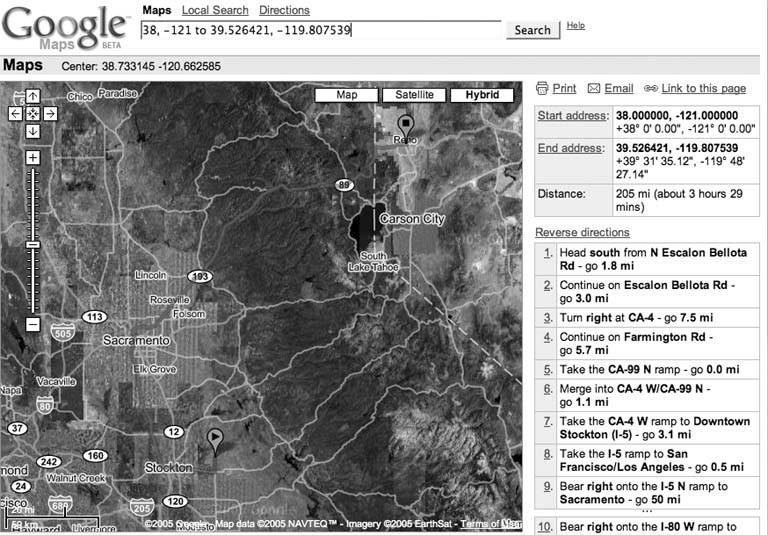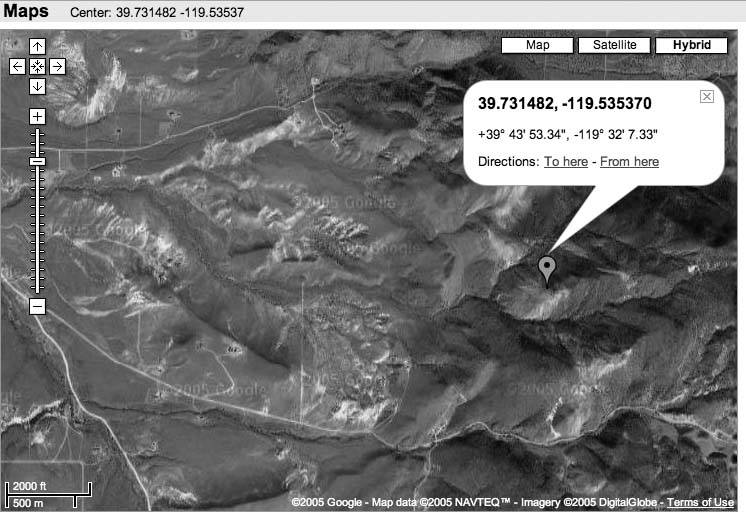Hack 36. Get Driving Directions for More Than Two Locations


Going from here to there is okay, but going from here to there to another there to here is better.
In "Load Driving Directions into Your GPS" [Hack #35] we saw how to compute a route and load it into a GPS. The hack showed how to directly create a URL that will fetch the Google Maps file that contains the route points. GPSBabel can parse the points out of a route file and you can do whatever you would like with this information.
This suggests a script that takes a list of locations that Google can understand and then generates driving directions between each point. In addition to normal locations such as "San Francisco, CA to Denver, CO," Google Maps can generate driving directions based on latitude and longitude. The results of searching for directions from 38, -121 to 39.526421, -119.807539 are shown in Figure 4-19.
Figure 4-19. Directions from latitude/longitude to latitude/longitude

Lat/long routes don't always work. There are some places that are just a bit too far off of the beaten track for road-based routing to be effective. If you try 38, -121 to 39.731482, -119.53537, you get "We could not calculate driving directions between 38, -121 and 39.731482, -119.53537." Since 38, -121 worked in the first example, Google must have a problem with 39.731482, -119.53537. A glance at Figure 4-20 shows that Google should be forgiven for this routing difficulty. Apparently the engineers didn't anticipate helicopter-based mountain-top expeditions.
But lat/longbased directions work often enough to be interesting. Great, but why would you want to get driving directions for multiple points or for lat/longs? Let's say you want to drive from San Francisco to Denver; you can generate the route in Figure 4-21 with the query SFO to DEN, using an airport-to-airport search. Why do you need more than one set of directions?
You've got everything you need1,299 miles, and you are there. But it turns out you want to stop in Moab for some of that Slickrock action. You can't (yet) enter a request to Google for multipart driving directions, such as SFO to Moab, UT to DEN, but with this hack you can get something similar. Download the Perl script called takeme.pl from http://mappinghacks.com/projects/gmaps/takeme.html. The script can accept any combination of locations that Google can understand and GPS waypoints stored in GPX format. For example:
Figure 4-20. You can't always get driving directions to a lat/long

Figure 4-21. San Francisco and Denver are just a click apart

$ perl takeme.pl SFO to wy_small.gpx to Moab, UT, to DEN
The program returns the combination of driving directions from each point to the next, as well as a simplified list of lat/long points.
new route segment 37.61830, -122.38632 to 38.57320, -109.55060 San Francisco Airport to Slick Rock Capitol ----------------------------------------------------------------- Head west 0.5| mi (734 meters) for 1 min ----------------------------------------------------------------- Take the I-380 W ramp to San Francisco (I-280)/San Bruno 0.1| mi (197 meters) for 12 secs
You might want to specify multiple locations, including a detour to visit friends, or you might want to trick the routing algorithm into using a route that it considers sub-optimal. Here's a real life example of tricking a routing algorithm: my dad and step-mom had just gotten a Prius with a navigation systemthey had had it less than two weeks. My dad, while quite bright, is not particularly technical. One day they were driving and playing with the navigation system. My dad said, "Don't set it to go to our destination until you get to this turnit will take us a bad way from here."
My nontechnical dad had figured out the tool in under a week. Without knowing how, he was dynamically gaming the system's shortest-path algorithm by artificially increasing the weight of one segment by adding the cost of turning around to get back to that segment. He made that segment less attractive to the routing algorithm by inserting another segment in between himself and the dreaded slower path. Specifying intermediate points (or desired side trips) adds local knowledge to the cost calculation used in the routing system. In Google Maps terms, it sure would be nice to have "do not use this segment" checkboxes next to each step in the route, followed by "recalculate my route without the checked segments," but until that happens, you can use the takeme.pl tool!
You Are Here: Introducing Google Maps
- Hacks 19: Introduction
- Hack 1. Get Around http://maps.google.com
- Hack 2. Find Yourself (and Others) on Google Maps
- Hack 3. Navigate the World in Your Web Browser
- Hack 4. Get the Birds-Eye View
- Hack 5. Driven to a Better User Interface
- Hack 6. Share Google Maps
- Hack 7. Inside Google Maps URLs
- Hack 8. Generate Links to Google Maps in a Spreadsheet
- Hack 9. Use del.icio.us to Keep Up with Google Maps
Introducing the Google Maps API
- Hacks 1016: Introduction
- Hack 10. Add a Google Map to Your Web Site
- Hack 11. Where Did the User Click?
- Hack 12. How Far Is That? Go Beyond Driving Directions
- Hack 13. Create a Route with a Click (or Two)
- Hack 14. Create Custom Map Markers
- Hack 15. Map a Slideshow of Your Travels
- Hack 16. How Big Is the World?
Mashing Up Google Maps
- Hacks 1728: Introduction
- Hack 17. Map the News
- Hack 18. Examine Patterns of Criminal Activity
- Hack 19. Map Local Weather Conditions
- Hack 20. Track Official Storm Reporting
- Hack 21. Track the International Space Station
- Hack 22. Witness the Effects of a Nuclear Explosion
- Hack 23. Find a Place to Live
- Hack 24. Search for Events by Location
- Hack 25. Track Your UPS Packages
- Hack 26. Follow Your Packets Across the Internet
- Hack 27. Add Google Maps to Any Web Site
- Hack 28. How Big Is That, Exactly?
On the Road with Google Maps
- Hacks 2941: Introduction
- Hack 29. Find the Best Gasoline Prices
- Hack 30. Stay Out of Traffic Jams
- Hack 31. Navigate Public Transportation
- Hack 32. Locate a Phone Number
- Hack 33. Why Your Cell Phone Doesnt Work There
- Hack 34. Publish Your Own Hiking Trail Maps
- Hack 35. Load Driving Directions into Your GPS
- Hack 36. Get Driving Directions for More Than Two Locations
- Hack 37. View Your GPS Tracklogs in Google Maps
- Hack 38. Map Your Wardriving Expeditions
- Hack 39. Track Your Every Move with Google Earth
- Hack 40. The Ghost in Google Ride Finder
- Hack 41. How Google Maps Got Me Out of a Traffic Ticket
Google Maps in Words and Pictures
- Hacks 4250: Introduction
- Hack 42. Get More out of What You Read
- Hack 43. Dont Believe Everything You Read on a Map
- Hack 44. You Got Your A9 Local in My Google Maps!
- Hack 45. Share Pictures with Your Community
- Hack 46. Browse Photography by Shooting Location
- Hack 47. Geotag Your Own Photos on Flickr
- Hack 48. Tell Your Communitys Story
- Hack 49. Generate Geocoded RSS from Any Google Map
- Hack 50. Geoblog with Google Maps in Thingster
API Tips and Tricks
- Hacks 5161: Introduction
- Hack 51. Make a Fullscreen Map the Right Way
- Hack 52. Put a Map and HTML into Your Info Windows
- Hack 53. Add Flash Applets to Your Google Maps
- Hack 54. Add a Nicer Info Window to Your Map with TLabel
- Hack 55. Put Photographs on Your Google Maps
- Hack 56. Pin Your Own Maps to Google Maps with TPhoto
- Hack 57. Do a Local Zoom with GxMagnifier
- Hack 58. Find the Right Zoom Level
- Hack 59. Show Lots of StuffQuickly
- Hack 60. Make Things Happen When the Map Moves
- Hack 61. Use the Right Developers Key Automatically
Extreme Google Maps Hacks
- Hacks 6270: Introduction
- Hack 62. Find the Latitude and Longitude of a Street Address
- Hack 63. Read and Write Markers from a MySQL Database
- Hack 64. Build Custom Icons on the Fly
- Hack 65. Add More Imagery with a WMS Interface
- Hack 66. Add Your Own Custom Map
- Hack 67. Serve Custom Map Imagery
- Hack 68. Automatically Cut and Name Custom Map Tiles
- Hack 69. Cluster Markers at High Zoom Levels
- Hack 70. Will the Kids Barf? (and Other Cool Ways to Use Google Maps)
EAN: 2147483647
Pages: 131
